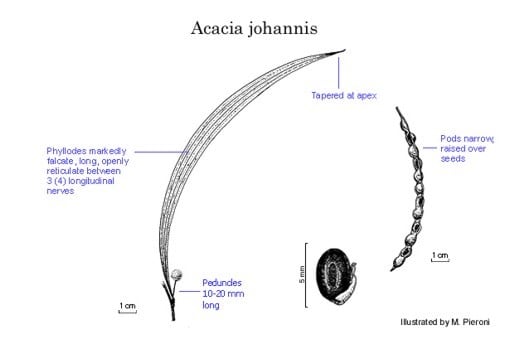Acacia johannis Pedley
WATTLE
Acacias of Australia
Family
Fabaceae
Distribution
Restricted to NE Qld where common on Mt Mulligan, sometimes forming thickets.
Description
Shrub to 2 m tall. Branchlets glabrous, reddish brown, lenticellate. Phyllodes narrowly elliptic, markedly falcate, 14–18 cm long, 5–10 (–14) mm wide, glabrous, acute with a callus point; longitudinal nerves 3 (or 4), prominent, with secondary nerves indistinct, forming open anastomoses; gland basal, prominent; pulvinus 1.5–2 mm long. Heads single or in pairs on short axillary axis, c. 50-flowered, lemon-yellow; peduncles glabrous, 10–20 mm long; basal bract minute. Flowers 5-merous; calyx c. 1.5 mm long, divided almost to base, ciliolate; corolla deeply divided, with lobes 1.8–2 mm long, glabrous; stamens 3–4 mm long; ovary glabrous. Pods shortly stipitate, linear, straight, 7–10 cm long, 5–7 mm wide, glabrous; thinly coriaceous, shallowly to moderately constricted between seeds and prominently rounded over them alternately on each valve. Seeds longitudinal, dark brown, depressed elliptic, 3–3.5 mm long, 2.5 mm wide; aril clavate.
Phenology
Flowering material collected Feb. & Apr.; fruiting material Apr. & July.
Habitat
Occurs on rock outcrops and pavements and in shallow rocky soils derived from sandstone.
Specimens
Qld: Mt Pinnacle, SSW of Dimbulah, A.R.Bean 5578 & P.I.Forster (BRI, DNA); 3.3 km S of crossing of Shepherd Ck on Maytown track, J.R.Clarkson 9615 & P.Neldner (BRI, K, MBA, MEL, NSW, PERTH); Mt Mulligan, J.R.Clarkson 5805 (BRI, K, MBA, MEL, NSW, PERTH); Mt Mulligan, J.R.Clarkson 6927 (BRI, K, MBA, MEL, NSW, QRS).
Notes
Acacia johannis is most closely related to A. armillata, A. legnota and A. ommatosperma. It differs most obviously from A. armillata in its more obviously falcate phyllodes with fewer prominent longitudinal nerves and generally narrower pods that are prominently rounded over the somewhat smaller seeds; from A. legnota in phyllodes with fewer longitudinal nerves and pods narrower; and from A. ommatosperma in its shorter, recurved phyllodes that are narrowed toward their apices, generally shorter peduncles and narrower pods.
FOA Reference
Data derived from Flora of Australia Volumes 11A (2001), 11B (2001) and 12 (1998), products of ABRS, ©Commonwealth of Australia
Author
L.Pedley
Minor edits by B.R.Maslin
This identification key and fact sheets are available as a mobile application:
URL: https://apps.lucidcentral.org/wattle/
© Copyright 2018. All rights reserved.







